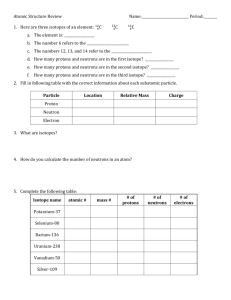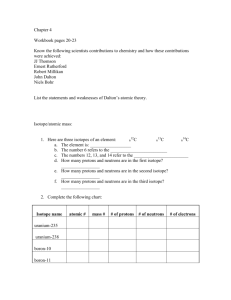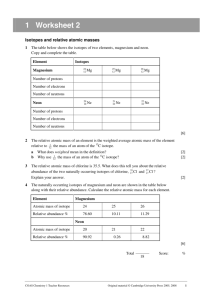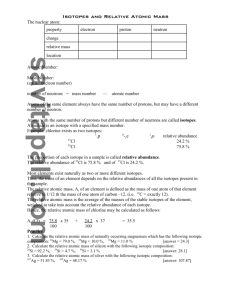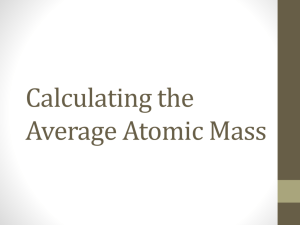Isotopes and Atomic Mass - SCH3U-CCVI
advertisement
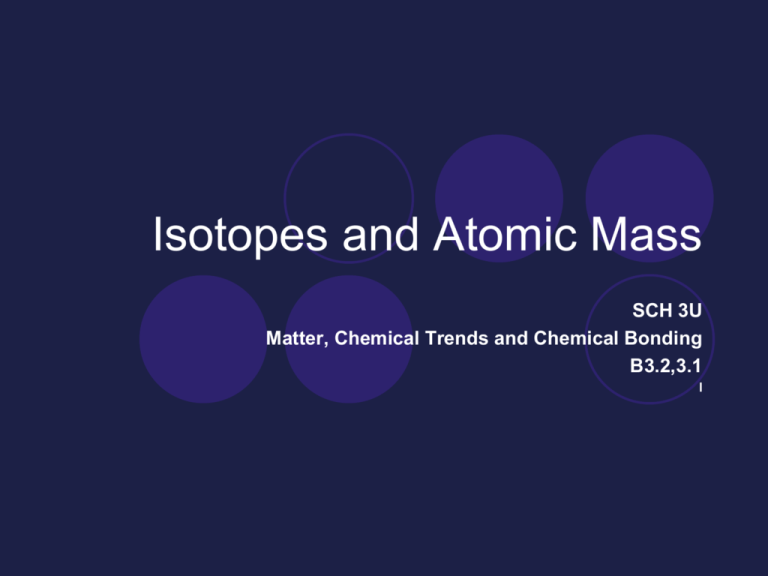
Isotopes and Atomic Mass SCH 3U Matter, Chemical Trends and Chemical Bonding B3.2,3.1 l What are Isotopes? Two atoms are isotopes if they have the same number of protons, but they have different numbers of neutrons. This means that: Isotopes are atoms of the same element. Isotopes have different atomic masses. Isotopes have different number of neutrons in their nuclei. Comparing isotopes of Magnesium Magnesium has 3 isotopes, here is how they compare: Magnesium-24 Magesium-25 Magnesium-26 12 protons 12 protons 12 protons 12 neutrons 12 electrons Isotope mass 24u 13 neutrons 12 electrons Isotope mass 25u 14 neutrons 12 electrons Isotope mass 26u Comparing the isotopes of Magnesium Similarities: Same number of protons. Same number of electrons. Same appearance and chemical properties. Differences: Different number of neutrons. Different atomic masses. Isotopic Abundance (% Abundance) A sample of magnesium is a mixture of the three isotopes of magnesium. Each isotope is a fraction of the mixture, and has its own isotopic abundance (expressed as a percentage of the whole). The isotopic abundance is fixed so that every sample of the element (in the universe) has the same proportions of the isotopes. Isotopic Abundance A sample of magnesium is a mixture of three isotopes, present as: 79% Mg-24 10% Mg-25 11% Mg-26 Average Atomic Mass and Isotope Abundance The Average Atomic Mass seen on the Periodic Table is a weighted average of all of the isotope masses. The weighted average takes into account the isotope masses and their percent abundances. In a weighted average calculation, the isotope with the greatest % abundance has the biggest influence on the average atomic mass. Average Atomic Mass The average atomic mass is a weighted average of all the isotope masses for a particular element. When you calculate average atomic mass, you need three pieces of information: The number of isotopes The masses of each isotope The % abundance of each isotope Average Atomic Mass The average atomic mass for carbon on the Periodic table is 12.01u. This means: Carbon has more than one isotope; One of carbon’s isotopes has a mass of 12, another is greater than 12; The most abundant isotope is Carbon-12. Calculating Average Atomic Mass Use the equation: AAM (u) = % ab1 x mass1 + % ab2 x mass2 + … % abn x massn Where: AAM = Average Atomic Mass %ab1 = Percent abundance of isotope 1 mass1 = Mass of isotope 1 Sample Problem (p 167) Silver has two naturally occuring isotopes, Ag-107 (m=106.9u) and Ag-109 (m=108.9u) with isotopic abundances of 51.8% and 48.2% respectively. Calculate the average atomic mass of silver. AAM (u) = % ab1 x mass1 + % ab2 x mass2 AAM (u) = (0.518)x 106.9u + (0.482u) x 108.9u AAM (u) = 55.4u + 52.5u AAM (u) = 107.9u Sample Problem (p 169) Boron exists as two naturally occuring isotopes: Boron-10 (10.01u) and Boron-11(11.01). Calculate the relative abundance of each isotope, if the average atomic mass of boron is 10.81u. To solve, The percent abundance of all the isotopes should add up to 1. The % abundance of boron-10 is (x), and the % abundance of boron-11 is (1-x). Sample Problem (p 169 – continued) Solution: AAM (u) = % ab1 x mass1 + % ab2 x mass2 10.81 = x(10.01) + (1-x) (11.01) 10.81 = 10.01x + 11.01 – 11.01x 11.01x-10.01x = 11.01 -10.81 x = 0.2000 The abundance of Boron-10 is 20.0% The abundance of Boron-11 is (1-x) or 80.0%


